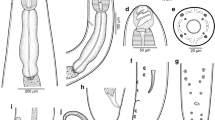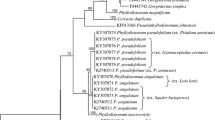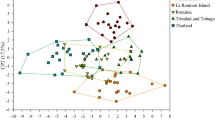Abstract
Cucullanus pinnai has been divided in two subspecies (C. pinnai pinnai and C. pinnai pterodorasi) based on the morphology of oesophastome. While C. pinnai pinnai apparently shows low host specificity and broad geographic occurrence, with certain morphological variations, C. pinnai pterodorasi was reported once, parasitizing Pterodoras granulosus. We used an integrative taxonomic approach to evaluate whether or not populations of C. pinnai pinnai from Trychomycterus spegazzinii (Escoipe River, Argentina) and Pimelodus fur (Miranda River, Brazil), and of C. pinnai pterodorasi from Pterodoras granulosus (Miranda River, Brazil) are conspecific. Parasites were observed using light microscopy and genetically characterized based on partial sequences of the 18S and 28S rDNA, ITS1-5.8S-ITS2, and COI mtDNA. Phylogenies were reconstructed and the Generalized Mixed Yule Coalescent (GMYC), Poisson Tree Process (bPTP), and Automatic Barcode Gap Discovery (ABGD) were used for species delimitation purposes. The present samples formed well-supported monophyletic assemblages, corroborating in part the results of morphological analyses; however, they grouped according to geographic origin. Species delimitation suggested conspecificity of C. pinnai pinnai with C. pinnai pterodorasi from Brazil; consequently, the morphology of oesophastome may be an intraspecific variation. Results also indicated that C. pinnai may represent a species complex as samples from Argentina were suggestive of an independent specific entity. However, definitive affirmations are premature, since there is no autapomorphy for separating C. pinnai from Brazil and Argentina and sampling was limited to three host species from two river basins. The phylogenetic reconstructions also confirmed the artificiality of some genera within Cucullanidae.




Similar content being viewed by others
Data availability
All relevant data generated during this study are included in the article.
References
Ailán-Choke LG, Ramallo G, Nieva L, Davies D (2014) Helmintos parásitos de peces fluviales, provincia de Salta, Argentina. Acta Zool Lilloana 58:251–255
Ailán-Choke LG, Tavares LER, Luque JL, Pereira FB (2020) An integrative approach assesses the intraspecific variations of Procamallanus (Spirocamallanus) inopinatus, a common parasite in Neotropical freshwater fishes, and the phylogenetic patterns of Camallanidae. Parasitology 147:1752–1764. https://doi.org/10.1017/S0031182020001687
Ailán-Choke LG, Pereira FB (2021) Deep in the systematics of Camallanidae (Nematoda): using integrative taxonomy to better understand the phylogeny and consistency of diagnostic traits. Parasitology 148:962–974. https://doi.org/10.1017/S0031182021000706
Alves PV, de Chambrier A, Luque JL, Scholz T (2021) Integrative taxonomy reveals hidden cestode diversity in Pimelodus catfishes in the Neotropics. Zool Scr 50:2010–2224. https://doi.org/10.1111/zsc.12465
Anderson RC, Chabaud AG, Willmont S (2009) Keys to the nematode parasites of vertebrates. Archival Volumen. CABI Publising, Wallingford. https://doi.org/10.1079/9781845935726.0000
Bouckaert R, Vaughan TG, Barido-Sottani J, Duchêne S, Fourment M, Gavryushkina A, Heled J, Jones G, Kühnert D, De Maio N, Matschiner M, Mendes FK, Müller NF, Ogilvie HA, du Plessis L, Popinga A, Rambaut A, Rasmussen D, Siveroni I, Suchard MA, Wu C-H, Xie D, Zhang C, Stadler T, Drummond AJ (2019) BEAST 2.5: an advanced software platform for Bayesian evolutionary analysis. PLoS Comput Biol 15:e1006650. https://doi.org/10.1371/journal.pcbi.1006650
Bouckaert R, Drummond A (2017) bModelTest: Bayesian phylogenetic site model averaging and model comparison. BMC Evol Biol 17:42. https://doi.org/10.1186/s12862-017-0890-6
Bush AO, Lafferty KD, Lotz JM, Shostak AW (1997) Parasitology meets ecology on its own terms: Margolis et al. revisited. J Parasitol 83:575–583. https://doi.org/10.2307/3284227
Carstens BC, Pelletier TA, Reid NM, Satler JD (2013) How to fail at species delimitation. Mol Ecol 22:4369–4383. https://doi.org/10.1111/mec.12413
Chemes SB, Takemoto RM (2011) Diversity of parasites from middle Paraná system freshwater fishes, Argentina. Int J Biodivers Conserv 3:249–266
Chemes SB, Takemoto RM (2020) New records on parasitic helminths of Pimelodidae fishes in the Middle Paraná System (Argentina). Neotrop Helminthol 14:19–34. https://doi.org/10.24039/rnh2020141611
Choudhury A, Nadler SA (2016) Phylogenetic relationships of Cucullanidae (Nematoda) with observations on Seuratoidea and the monophyly of Cucullanus, Dichelyne and Truttaedacnitis. J Parasitol 102:87–93. https://doi.org/10.1645/15-806
Cole R, Viney M (2018) The population genetics of parasitic nematodes of wild animals. Parasit Vectors 11:590. https://doi.org/10.1186/s13071-018-3137-5
Dellicour S, Flot JF (2018) The hitchhiker’s guide to single-locus species delimitation. Mol Ecol Resour 18:1234–1246. https://doi.org/10.1111/1755-0998.12908
Di Renzo L, Di Gialleonardo L, Marchiori E, Di Francesco G, Curini V, Cocco A, Guccione S, Ferri N, Marcer F, Cammà C, Pascucci I (2021) Cucullanus carettae Baylis, 1923, in a loggerhead sea turtle (Caretta caretta) from the Adriatic sea: first detection and molecular characterization. Parasitol Res 120:341–345. https://doi.org/10.1007/s00436-020-06936-5
Froese R, Pauly D (2022) Fish base. World Wide Web Electronic Publication. https://www.fishbase.org. Accessed 13 Dec 2022
González-Solís D, Tuz-Paredes VM, Quintal-Loria MA (2007) Cucullanus pargi sp n (Nematoda: Cucullanidae) from the gray snapper Lutjanus griseus off the southern coast of Quintana Roo, Mexico. Folia Parasitol 54:220–224. https://doi.org/10.14411/fp.2007.030
Hamann MI (1985) Presencia de Cucullanus pinnai Travassos, Artigas y Pereira 1928 en peces del Río Paraná Medio, provincia de Corrientes, Argentina (Nematoda, Cucullanidae). Hist Nat 5:147–148
Isbert W, Montero FE, Carrassón M, González-Solís D (2015) Dichelyne (Cucullanellus) romani n. sp. (Nematoda: Cucullanidae) in notacanthid fishes from the Northeast Atlantic and Western Mediterranean. Syst Parasitol 91:35–47. https://doi.org/10.1007/s11230-015-9556-1
Kimura M (1980) A simple method for estimating evolutionary rates of base substitutions through comparative studies of nucleotide sequences. J Mol Evol 16:111–120
Kohn A, Moravec F, Cohen SC, Canzi C, Takemoto RM, Fernandes BM (2011) Helminths of freshwater fishes in the reservoir of the Hydroelectric Power Station of Itaipu, Paraná, Brazil. Check List 7:681–690. https://doi.org/10.15560/7.5.681
Li L, Du L-Q, Xu Z, Guo Y-N, Wang S-X, Zhang L-P (2014a) Morphological variability and molecular characterisation of Dichelyne (Cucullanellus) pleuronectidis (Yamaguti, 1935) (Ascaridida: Cucullanidae) from the flatfish Pleuronichthys cornutus (Temminck & Schlegel) (Pleuronectiformes: Pleuronectidae) in the East China Sea. Syst Parasitol 87:87–98. https://doi.org/10.1007/s11230-013-9456-1
Li L, Xu Z, Zhang LP (2014b) Morphological and molecular evidence for a new species of the genus Dichelyne Jägerskiöld, 1902 (Ascaridida: Cucullanidae) from marine perciform fishes in the South China Sea. Syst Parasitol 89:107–116. https://doi.org/10.1007/s11230-014-9516-1
Li L, Ali AH, Zhao WT, Lü L, Xu Z (2016) First report on nematode parasite infection in the yellowbar angelfish Pomacanthus maculosus (Perciformes: Pomacanthidae) from the Iraqi coral reef, with description of a new species of Cucullanus (Nematoda: Ascaridida) using the integrated approaches. Parasitol Int 65:677–684. https://doi.org/10.1016/j.parint.2016.08.007
Moravec F (1998) Nematodes of freshwater fishes of the Neotropical Region. Academia, Prague
Moravec F, Kohn A, Fernandes BMM (1993) Nematode parasites of fishes of the Paraná River, Brazil. Part 2. Seuratoidea, Ascaridoidea, Habronematoidea and Acuarioidea. Folia Parasitol 40:115–134
Moravec F, Kohn A, Fernandes BMM (1997) Observations on seuratoid nematodes parasitic in fishes of the Paraná River, Brasil. Folia Parasitol 44:209–223
Moravec F, Sasal R, Würtz J, Taraschewski H (2005) Cucullanus oceanensis (Nematoda: Cucullanidae) from Pacific eels (Anguilla spp.). Syst Parasitol 52:342–348. https://doi.org/10.14411/fp.2005.047
Notredame C, Higgins DG, Heringa J (2000) T-Coffee: a novel method for fast and accurate multiple sequence alignment. J Mol Biol 302:205–217. https://doi.org/10.1006/jmbi.2000.4042
Park JK, Sultana T, Lee SH, Kang S, Kim HK, Min GS, Eom KS, Nadler SA (2011) Monophyly of clade III nematodes is not supported by phylogenetic analysis of complete mitochondrial genome sequences. BMC Genomics 12:392. https://doi.org/10.1186/1471-2164-12-392
Pereira FB, Vieira FM, Luque JL (2014) A new species of Cucullanus (Nematoda: Cucullanidae) from the grey triggerfish Balistes capriscus Gmelin (Osteichthyes: Balistidae) off Rio de Janeiro, Brazil. Syst Parasitol 87:283–291. https://doi.org/10.1007/s11230-014-9470-y
Pereira FB, Luque JL (2016) Morphological and molecular characterization of cucullanid nematodes including Cucullanus opisthoporus in freshwater fish from the Brazilian Amazon. J Helminthol 91:739–751. https://doi.org/10.1017/S0022149X16000729
Pérez-i-García D, Constenla M, Padrós F, Soler-Membrives A, Solé M, Carrassón M (2015) Parasite communities of the deep-sea fish Alepocephalus rostratus Risso, 1820 in the Balearic Sea (NW Mediterranean) along the slope and relationships with enzymatic biomarkers and health indicators. Deep-Sea Res i: Oceanogr Res Pap 99:65–74. https://doi.org/10.1016/j.dsr.2015.01.009
Pérez-Ponce de León G, García-Varela M, Sereno-Uribe AL, Poulin R (2016) Species delimitation in trematodes using DNA sequences: Middle-American Clinostomum as a case study. Parasitology 143:1773–1789. https://doi.org/10.1017/S0031182016001517
Pinacho-Pinacho CD, García-Varela M, Sereno-Uribe AL, Pérez-Ponce de León G (2018) A hyper-diverse genus of acanthocephalans revealed by tree-based and non-tree-based species delimiation methods: ten cryptic species of Neoechinorhynchus in Middle American freshwater fishes. Mol Phylogenetics Evol 127:30–45. https://doi.org/10.1016/j.ympev.2018.05.023
Petter AJ (1995) Dichelyne moraveci n. sp., parasite de Pseudoplatystoma fasciatum et notes sur les Cucullanidae du Paraguay. Rev Suisse Zool 102:769–778
Petter AJ (1974) Essai de classification de la famille des Cucullanidae. Bull. Mus. Natl. Hist. Nat. Paris, series 3. Zoologie 177:1469–1491
Pinheiro RHDS, Santana RLS, Monks S, Santos JND, Giese EG (2018) Cucullanus marajoara n. sp. (Nematoda: Cucullanidae), a parasite of Colomesus psittacus (Osteichthyes: Tetraodontiformes) in the Marajó, Brazil. Rev Bras Parasitol Vet 27:521–530. https://doi.org/10.1590/S1984-296120180072
Pons J, Barraclough TG, Gomez-Zurita J, Cardoso A, Duran DP, Hazell S, Kamoun S, Sumlin WD, Vogler AP (2006) Sequence-based species delimitation for the DNA taxonomy of undescribed insects. Syst Biol 55:595–609. https://doi.org/10.1080/10635150600852011
Puillandre N, Lambert A, Brouillet S, Achaz G (2012) ABGD, Automatic Barcode Gap Discovery for primary species delimitation. Mol Ecol 21:1864–1877. https://doi.org/10.1111/j.1365-294X.2011.05239.x
Ramallo G (1999) Nematodos parásitos de peces del embalse de Termas de Río Hondo, Santiago del Estero, Argentina. Bol Chil Parasitol 54:3–6. https://doi.org/10.22179/revmacn.21.621
Rambaudt A, Drummond AJ, Xie D, Baele G, Suchard MA (2018) Posterior summarization in Bayesian phylogenetics using Tracer 1.7. Syst Biol 67:901–904. https://doi.org/10.1093/sysbio/syy032
Razkin O, Sonet G, Breugelmans K, Madeira MJ, Gómez-Moliner BJ, Backeljau T (2016) Species limits, interspecific hybridization and phylogeny in the cryptic land snail complex Pyramidula: the power of RADseq data. Mol Phylogenet Evol 101:267–278. https://doi.org/10.1016/j.ympev.2016.05.002
Russel PM, Brewer BJ, Klaere S, Bouckaert RR (2019) Model selection and parameter inference in phylogenetics using nested sampling. Syst Biol 68:219–233. https://doi.org/10.1093/sysbio/syy050
Sayad S, Yassin A (2019) Quantifying the extent of morphological homoplasy: a phylogenetic analysis of 490 characters in Drosophila. Evol Lett 3:286–298. https://doi.org/10.1002/evl3.115
Tanzola RD, Guagliardo SE, Poggi C, Angeletti B, Schwerdt CB (2020) Acerca del ciclo de vida de Cucullanus pinnai pinnai (Travassos, Artigas & Pereira, 1928) (Nematoda: Cucullanidae) parásitos de Rhamdia quelen (Quoy & Gaimard, 1824) (Siluriformes) en su distribución mas meridional. Neotrop Helminthol 14: 217–225. https://doi.org/10.24039/rnh2020142808
Travassos L, Artigas P, Pereira C (1928) Fauna helmintológica dos peixes de água doce do Brasil. Arq Instit Biol 1:5–68
Valadão MC, López-Hernández D, Alves PV, Pinto HA (2022) A new species of Echinostoma (Trematoda: Echinostomatidae) from the ‘revolutum’ group in Brazil: refuting the occurrence of Echinostoma miyagawai (= E. robustum) in the Americas. Parasitology 149:325–336. https://doi.org/10.1017/S0031182021001864
Van Der Wal C, Ahyong ST, Ho SYW, Lins LSF, Lo N (2019) Combining morphological and molecular data resolves the phylogeny of Squilloidea (Crustacea: Malacostraca). Invertebr Syst 33:89–100. https://doi.org/10.1071/IS18035
Vieira VS, Vieira FM, Luque JL (2015a) New morphological data on Cucullanus pinnai pinnai (Nematoda) parasitizing Pimelodus maculatus (Pimelodidae) in southeastern Brazil. Rev Bras Parasitol Vet 24:155–161. https://doi.org/10.1590/S1984-29612015028
Vieira FM, Pereira FB, Pantoja C, Soares IA, Pereira AN, Timi JT, Scholz T, Luque JL (2015b) A survey of nematodes of the genus Cucullanus Müller, 1777 (Nematoda, Seuratoidea) parasitic in marine fishes off Brazil, including description of three new species. Zootaxa 4039:289–311. https://doi.org/10.11646/zootaxa.4039.2.5
Xia X (2018) DAMBE 7: new and improved tools for data analysis in molecular biology and evolution. Mol Biol Evol 35:1550–1552. https://doi.org/10.1093/molbev/msy073
Xia X, Xie Z, Li WH (2003) Effects of GC content and mutational pressure on the lengths of exons and coding sequences. J Mol Evol 56:362–370. https://doi.org/10.1007/s00239-002-2406-1
Xu Z, Chen H-X, Ju H-D, Li L (2017) Morphological and molecular characterization of Cucullanus bourdini Petter et Le Bel, 1992 (Ascaridida: Cucullanidae) from the yellowback fusilier Caesio xanthonota Bleeker (Perciformes: Caesionidae). Acta Parasitol 62:199–206. https://doi.org/10.1515/ap-2017-0024
Xu Z, Zhang LP, Li L (2014) Morphological and molecular characterization of Cucullanus hainanensis sp. nov. (Ascaridida: Cucullanidae) from Muraenichthys gymnopterus (Bleeker) (Anguilliformes: Ophichthidae) in the South China Sea. Acta Parasitol 59:710–716. https://doi.org/10.2478/s11686-014-0303-6
Yooyen T, Moravec F, Wongsawad C (2011) Two new species of Cucullanus Müller, 1777 (Nematoda: Cucullanidae) from marine fishes off Thailand. Syst Parasitol 78:139–149. https://doi.org/10.1007/s11230-010-9286-3
Zhang J, Kapli P, Pavlidis P, Stamatakis A (2013) A general species delimitation method with applications to phylogenetic placements. Bioinformatics 29:2869–2876. https://doi.org/10.1093/bioinformatics/btt499
Acknowledgements
The authors would like to thank Dr. Fernando Paiva from Universidade Federal de Mato Grosso do Sul for support during field collections and Dr. Carina Elisei from Universidade Católica Dom Bosco for support during laboratorial genetic procedures. Thanks are also due to Florencia Liquin, Jose Saravia, and Roberto Sanchez for their assistance in field collections and laboratorial procedures.
Funding
This work was financed in part by the Fondo para la Investigación Científica y Tecnológica (FONCyT PICT-2020–02399) and Consejo de Investigación, Universidad Nacional de Salta, Argentina (grant number 2481/0). JVC was supported the Coordenação de Aperfeiçoamento de Pessoal de Nível Superior, Brasil (CAPES, Finance Code 001). FBP was supported by the Fundação de Amparo à Pesquisa do Estado de Minas Gerais (FAPEMIG, Process no. APQ-01179–21). JLL was supported by a research fellowship of the Conselho Nacional de Desenvolvimento Científico e Tecnológico do Brasil (CNPq). LAC was supported by a Post-doctoral fellowship from the Consejo Nacional de Investigaciones Científicas y Técnicas (CONICET, Argentina).
Author information
Authors and Affiliations
Contributions
Conceptualization and study designs: Felipe Bisaggio Pereira and Lorena Gisella Ailán-Choke. Investigation and sampling: all authors. Laboratory analyses: Felipe Bisaggio Pereira, Lorena Gisella Ailán-Choke and Lennon Souza Malta. Data analyses and compilation: Felipe Bisaggio Pereira, Lorena Gisella Ailán-Choke and João Victor Couto. Drawing preparation: Lennon Souza Malta. Writing of the original draft: Felipe Bisaggio Pereira, Lorena Gisella Ailán-Choke. All the authors reviewed the manuscript. Supervision: Felipe Bisaggio Pereira.
Corresponding author
Ethics declarations
Ethics approval
All procedures performed in studies involving animals were in accordance with the ethical standards of the institutions or practice at which the studies were conducted. The study was approved by the Secretaría de Medio Ambiente, Ministerio de Ambiente y Producción Sustentable, Gobierno de la provincia de Salta, Argentina (Authorization N° 000340/16) and Sistema de Informação e Autorização em Biodiversidade, Brazil (license number 54895).
Consent to participate
Not applicable.
Consent for publication
Not applicable.
Conflict of interest
The authors declare no competing interests.
Additional information
Handling Editor: Una Ryan
Publisher's note
Springer Nature remains neutral with regard to jurisdictional claims in published maps and institutional affiliations.
Supplementary Information
Below is the link to the electronic supplementary material.
Rights and permissions
Springer Nature or its licensor (e.g. a society or other partner) holds exclusive rights to this article under a publishing agreement with the author(s) or other rightsholder(s); author self-archiving of the accepted manuscript version of this article is solely governed by the terms of such publishing agreement and applicable law.
About this article
Cite this article
Ailán-Choke, L.G., Davies, D., Malta, L.S. et al. Cucullanus pinnai pinnai and C. pinnai pterodorasi (Nematoda Cucullanidae): what does the integrative taxonomy tell us about these species and subspecies classification?. Parasitol Res 122, 557–569 (2023). https://doi.org/10.1007/s00436-022-07758-3
Received:
Accepted:
Published:
Issue Date:
DOI: https://doi.org/10.1007/s00436-022-07758-3




